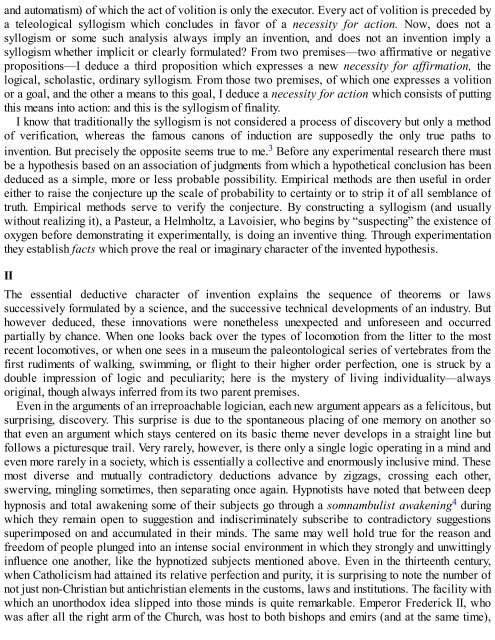3658925934
Create successful ePaper yourself
Turn your PDF publications into a flip-book with our unique Google optimized e-Paper software.
and automatism) of which the act of volition is only the executor. Every act of volition is preceded by<br />
a teleological syllogism which concludes in favor of a necessity for action. Now, does not a<br />
syllogism or some such analysis always imply an invention, and does not an invention imply a<br />
syllogism whether implicit or clearly formulated? From two premises—two affirmative or negative<br />
propositions—I deduce a third proposition which expresses a new necessity for affirmation, the<br />
logical, scholastic, ordinary syllogism. From those two premises, of which one expresses a volition<br />
or a goal, and the other a means to this goal, I deduce a necessity for action which consists of putting<br />
this means into action: and this is the syllogism of finality.<br />
I know that traditionally the syllogism is not considered a process of discovery but only a method<br />
of verification, whereas the famous canons of induction are supposedly the only true paths to<br />
invention. But precisely the opposite seems true to me. 3 Before any experimental research there must<br />
be a hypothesis based on an association of judgments from which a hypothetical conclusion has been<br />
deduced as a simple, more or less probable possibility. Empirical methods are then useful in order<br />
either to raise the conjecture up the scale of probability to certainty or to strip it of all semblance of<br />
truth. Empirical methods serve to verify the conjecture. By constructing a syllogism (and usually<br />
without realizing it), a Pasteur, a Helmholtz, a Lavoisier, who begins by “suspecting” the existence of<br />
oxygen before demonstrating it experimentally, is doing an inventive thing. Through experimentation<br />
they establish facts which prove the real or imaginary character of the invented hypothesis.<br />
II<br />
The essential deductive character of invention explains the sequence of theorems or laws<br />
successively formulated by a science, and the successive technical developments of an industry. But<br />
however deduced, these innovations were nonetheless unexpected and unforeseen and occurred<br />
partially by chance. When one looks back over the types of locomotion from the litter to the most<br />
recent locomotives, or when one sees in a museum the paleontological series of vertebrates from the<br />
first rudiments of walking, swimming, or flight to their higher order perfection, one is struck by a<br />
double impression of logic and peculiarity; here is the mystery of living individuality—always<br />
original, though always inferred from its two parent premises.<br />
Even in the arguments of an irreproachable logician, each new argument appears as a felicitous, but<br />
surprising, discovery. This surprise is due to the spontaneous placing of one memory on another so<br />
that even an argument which stays centered on its basic theme never develops in a straight line but<br />
follows a picturesque trail. Very rarely, however, is there only a single logic operating in a mind and<br />
even more rarely in a society, which is essentially a collective and enormously inclusive mind. These<br />
most diverse and mutually contradictory deductions advance by zigzags, crossing each other,<br />
swerving, mingling sometimes, then separating once again. Hypnotists have noted that between deep<br />
hypnosis and total awakening some of their subjects go through a somnambulist awakening 4 during<br />
which they remain open to suggestion and indiscriminately subscribe to contradictory suggestions<br />
superimposed on and accumulated in their minds. The same may well hold true for the reason and<br />
freedom of people plunged into an intense social environment in which they strongly and unwittingly<br />
influence one another, like the hypnotized subjects mentioned above. Even in the thirteenth century,<br />
when Catholicism had attained its relative perfection and purity, it is surprising to note the number of<br />
not just non-Christian but antichristian elements in the customs, laws and institutions. The facility with<br />
which an unorthodox idea slipped into those minds is quite remarkable. Emperor Frederick II, who<br />
was after all the right arm of the Church, was host to both bishops and emirs (and at the same time),









![Genki - An Integrated Course in Elementary Japanese II [Second Edition] (2011), WITH PDF BOOKMARKS!](https://img.yumpu.com/58322134/1/180x260/genki-an-integrated-course-in-elementary-japanese-ii-second-edition-2011-with-pdf-bookmarks.jpg?quality=85)
![Genki - An Integrated Course in Elementary Japanese I [Second Edition] (2011), WITH PDF BOOKMARKS!](https://img.yumpu.com/58322120/1/182x260/genki-an-integrated-course-in-elementary-japanese-i-second-edition-2011-with-pdf-bookmarks.jpg?quality=85)





